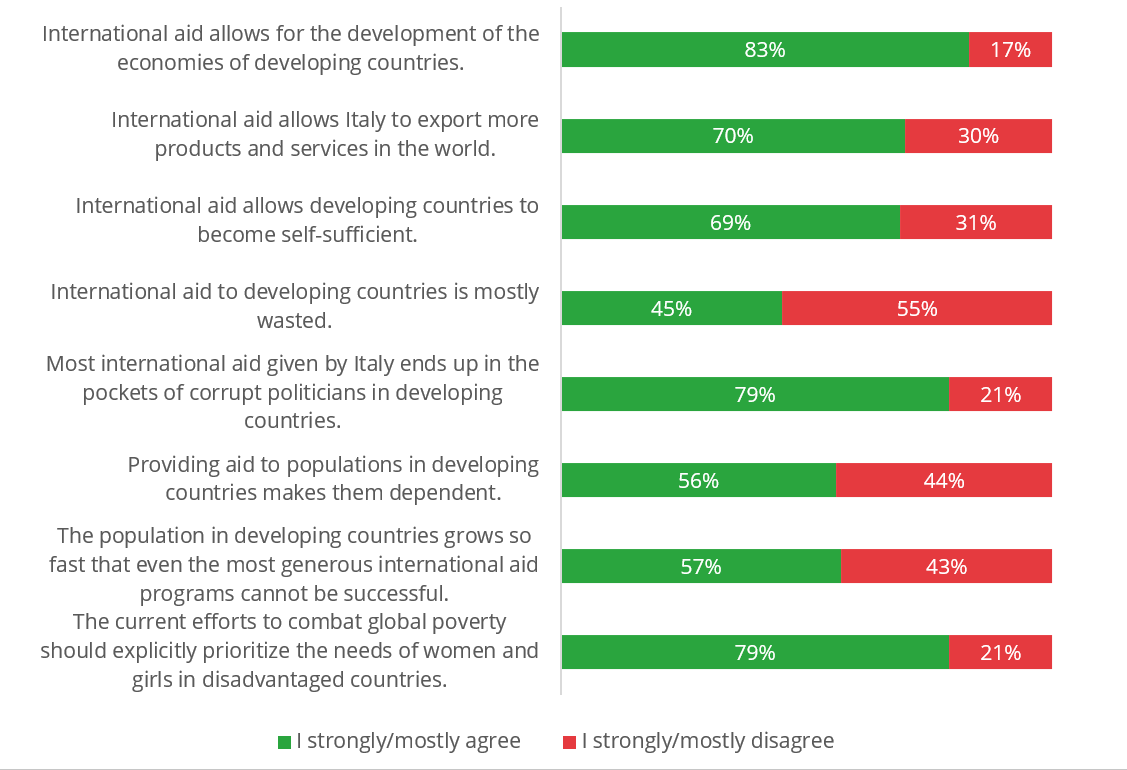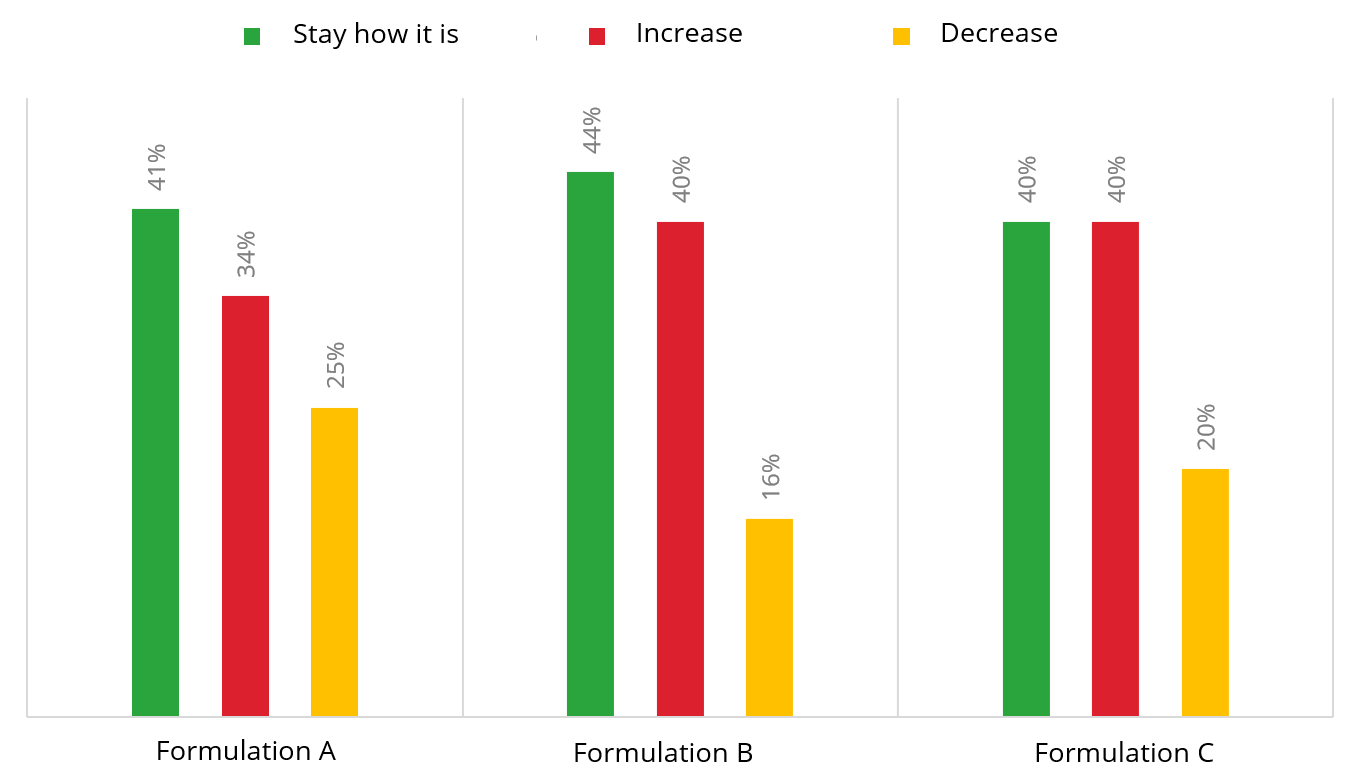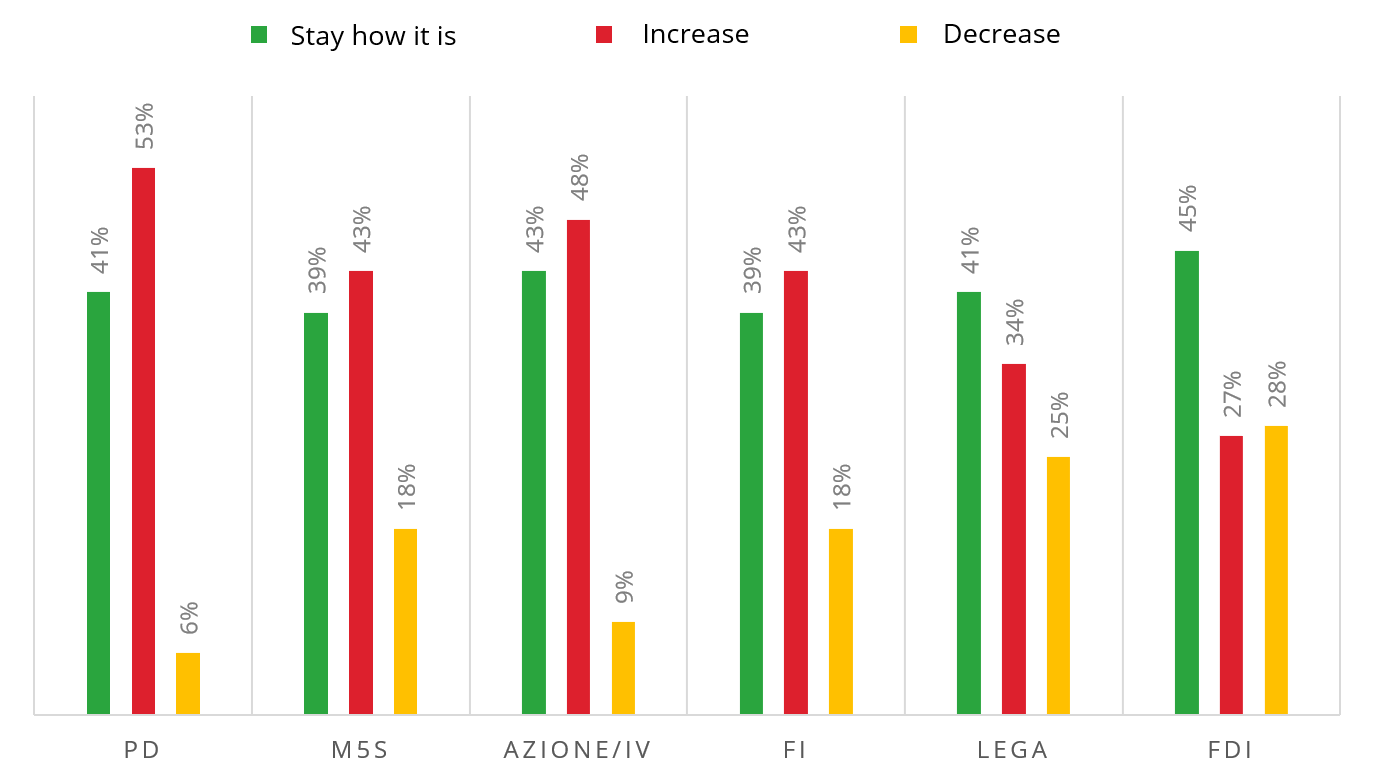Present and Future of Italy’s Development Cooperation
The Covid-19 pandemic and the war against Ukraine, with their significant socio-economic costs, have put stronger pressure on development assistance spending among traditional donors, as the cases of Sweden and the United Kingdom attest.[1] Confronted with higher energy costs, inflation and a potential recession, the political imperative across Europe is to allocate resources to tackle immediate domestic challenges rather than expanding international development programmes – against all the lessons of interdependence that the pandemic might have taught. Italy is not immune to this trend, as recent developments also seem to suggest.
What do Italians think of development cooperation?
A survey conducted in September 2022 by IAI and University of Siena’s LAPS[2] revealed that 84 per cent of Italian citizens believe it is important to finance development cooperation activities through aid (usually referred to as Official Development Assistance, or ODA). A vast majority (83 per cent) consider ODA as instrumental in supporting the economic development of partner countries. In addition, Italians generally perceive aid as a positive tool to increase the country’s international standing from an economic and political point of view. Seventy per cent of the interviewees believe aid contributes to growing exports, and 41 per cent consider that an increase in ODA spending would benefit Italy’s international prestige – a higher percentage than those who believe increased defence spending would do so (31 per cent).
However, Italians also share conflicting views on ODA. While 55 per cent of the surveyed sample do not think aid is wasted, 79 per cent believe most of these funds are eventually embezzled by corrupt politicians in partner countries. Moreover, although 69 per cent believe aid can help partner countries become self-sufficient, a consistent majority (56 per cent) also warn about the risk of making partner countries too dependent on external aid. Such discrepancy can be explained by respondents’ tendency to agree with statements in a survey (that is, acquiescence bias),[3] but it nevertheless depicts an interesting picture of Italians’ perception of ODA.
Figure 1 | General attitudes towards aid

Source: IAI-LAPS survey, 2022.
These attitudes might explain why a limited number (max. 25 per cent, depending on how the question was asked)[4] of the interviewees are in favour of cutting on ODA, whereas a larger group (up to 44 per cent) would be in favour of either maintaining the status quo or even increasing development cooperation funds (max. 40 per cent).
Figure 2 | Italians and support for ODA spending

Question: A) In 2021, the Italian government spent 0.28 per cent (7.688 billion, to be precise) of its gross national income (GNI) on international aid to developing countries. But like other developed countries, Italy has committed to spending 0.7 per cent by 2030. In your view, should spending for public development aid be increased, decreased, or remain at the current level? B) As the figure shows, Italy is in 18th place among countries that give development aid to poor and developing countries. In your view, should spending for aid to poor and developing countries...? C) In 2021, Italy spent 0.28 per cent of its GNI to assist developing countries, 1.4 per cent for military spending and 28 per cent for social spending. In your view, should spending for aid to poor and developing countries …? Source: IAI-LAPS survey 2022.
Differences are noticeable depending on party affiliation. On the one hand, left-wing (Democratic Party/PD), non-aligned (Five Star Movement/M5S) and centre-leaning/moderate voters (Azione/Italia Viva and Forza Italia/FI) would prefer increasing ODA spending rather than maintaining the status quo – the gap being the largest among PD voters. On the other hand, right-wing voters (Lega and Brothers of Italy/FDI) were less supportive of an ODA increase, with higher percentages in favour of a decrease in ODA – although, notably, a plurality within this group is in favour of the status quo (see Figure 3).
Figure 3 | Support for ODA spending by party

Source: IAI-LAPS survey, 2022.
International and Italian trends in ODA
In a socio-economic context deeply affected by spikes in energy prices and high inflation, ODA did not play a prominent role in the early months of Giorgia Meloni’s government. This does not come as a surprise and is in line with similar trends registered in other EU countries that risk impacting the EU’s prominent role in development cooperation policies. In 2021, EU member states allocated more than 65 billion euro to ODA, confirming the role of the Union as a global development “payer” (43 per cent of total funds reported to the OECD). Yet, this was a decrease compared with the previous year, amounting to less than 0.5 per cent (0.48 per cent) of the EU’s gross national income (GNI), a step back on the path towards the achievement of the internationally agreed 0.7 per cent ODA/GNI target.[5] Moreover, the EU is failing to meet the target to allocate between 0.15 and 0.20 per cent of its GNI to least developed countries (LDCs). In 2020, when consolidated data were last available, only five countries met this target – Luxembourg, Sweden, Denmark, Belgium and Germany; overall, ODA to LDCs represented 0.12 per cent of total EU members’ GNI.[6]
To be sure, eleven EU countries succeeded in increasing the ODA/GNI ratio in 2021. Italy also joined this group, with ODA growing from 0.22 per cent to 0.29 per cent of GNI.[7] However, in several countries, such an increase was primarily linked to so-called “inflated aid”: this refers to resources earmarked as development cooperation that arguably do not necessarily help vulnerable countries to tackle poverty, such as in-donor refugee costs, tuition fees for foreign students and debt relief operations.[8] These resources accounted for 10.3 billion euro at the EU level, or 15.9 per cent of total EU ODA in 2021.[9] Italy was not exempt from these trends, with most of the increase related to a debt relief operation for Somalia, a rise in in-donor refugees’ expenditures, as well as support to the multilateral system to address the pandemic (including through vaccine donations).[10]
Looking ahead, Italy’s Budget Law for 2023 allocates around 6.2 billion euro to various Ministries dealing with projects or initiatives with development cooperation purposes. These resources are mainly spread among the Ministry of Economy and Finances, the Ministry of Foreign Affairs and the Ministry of Interior, with the latter being assigned 1.5 billion euro mostly for “in-donor refugee costs”.[11] Based on the GDP growth forecasts for 2023, civil society organisations estimated that the overall allocation of the 2023 budget law might bring Italy’s ODA/GNI ratio to 0.31 per cent. While this would be a welcome increase, these resources are still far from the internationally agreed 0.7 per cent target.[12] In addition, practitioners and activists claim that, in line with a structural trend that affects Italy’s development cooperation policy, the Budget Law 2023 risks privileging multilateral aid (for example, internationally agreed and non-negotiable contributions to international organisations or initiatives) before bilateral aid.[13] Finally, in a similar vein, resources allocated to the Italian Agency for Development Cooperation have increased, but at a slower pace compared to what was envisaged in the previous 2022 budget law. The combination of these trends may have a significant impact on Italy’s capacity to deliver in key regions and thematic areas identified in the 2021–2023 plan for development cooperation,[14] by also affecting the multiple actors (non-governmental organisations, businesses, local authorities) engaged on the ground in the most vulnerable countries.
Future scenarios
Development cooperation is at a crossroads – in Italy and beyond. Some trends already present at the European level (for example, the growing role of inflated aid) have also been emerging in Italy in the last few years. Against this backdrop, the Italian government will have to put forward its new multi-year plan for development cooperation, which will set the geographic, thematic and financial priorities for Italy’s development cooperation policy for the next three years (2024–2026). If it is true that development cooperation is a marker of a country’s foreign policy, Italy will be asked to make important commitments in upcoming meetings such as the fifth United Nations Conference on the Least Developed Countries (LDC5) in Doha in March, the June Summit for a New Global Financial Pact or the UN SDG summit in September. Toward these meetings, the government should work in close cooperation with European allies to make sure that, despite the socio-economic impact of the war against Ukraine, the necessary resources are allocated at the European level to support the most vulnerable countries. This is key in view of the G7 Presidency in 2024, which will be a unique opportunity for the Italian government to lead on several initiatives that can have a strong impact on development cooperation.
Irene Paviotti is Junior Researcher in the Multilateralism and Global Governance programme at the Istituto Affari Internazionali (IAI). Daniele Fattibene is Associate Fellow at IAI and Coordinator of the European Think Tanks Group (ETTG).
This commentary was written in the context of “Building Back Forward: The Future of Italy’s Development Cooperation”, a project realised in partnership with Focus 2030, with the support of Fondazione Compagnia di San Paolo.
[1] Simon Rushton, “Sweden Cuts International Aid Budget but Raises Overall Spending”, in The National News, 8 November 2022, https://www.thenationalnews.com/world/europe/2022/11/08/sweden-cuts-international-aid-budget-but-raises-overall-spending; William Worley and David Ainsworth, “UK Aid Faces Third Major Cut in 3 Years, with £1.7B to Be Cut”, in Devex, 23 November 2022, https://www.devex.com/news/104513.
[2] LAPS and IAI, Italians and Official Development Assistance, Rome, IAI, December 2022, https://www.iai.it/en/node/16312.
[3] Timothy R. Graeff, “Response Bias”, in Kimberly Kempf-Leonard (ed.), Encyclopedia of Social Measurement, Vol. 3, Elsevier Science, 2005, p. 411-418.
[4] To investigate attitudes towards ODA spending, respondents were asked the same question in one of three comparable formulations (A, B, C). See Figure 2 for more details.
[5] For a backgrounder on this target, see OECD website: The 0.7% ODA/GNI Target - A History, https://www.oecd.org/dac/financing-sustainable-development/development-finance-standards/the07odagnitarget-ahistory.htm.
[6] Concord, AidWatch 2022. Is the EU a Payer, Player… or Just Full of Hot Air?, November 2022, p. 23, https://aidwatch.concordeurope.org/2022-report.
[7] OECD Data: Net ODA, https://data.oecd.org/oda/net-oda.htm.
[8] Concord, AidWatch 2017. EU Aid Uncovered. How to Reach the Target on Time, October 2017, https://concordeurope.org/2017/10/17/aidwatch-report-2017.
[9] Concord, AidWatch 2022, cit., p. 8, 17.
[10] OECD, ODA Levels in 2021 - Preliminary Data. Detailed Summary Note, 12 April 2022, p. 3, https://oe.cd/oda-summary-2021.
[11] Italian Ministry of Economy and Finance, Bilancio finanziario - 2023-2025. Allegato n. 28: Aiuto pubblico allo sviluppo, 16 January 2023, https://www.rgs.mef.gov.it/_Documenti/VERSIONE-I/attivita_istituzionali/formazione_e_gestione_del_bilancio/bilancio_di_previsione/bilancio_finanziario/2023-2025/APS_LB_2023_pubblicazione.pdf.
[12] Openpolis, La cooperazione allo sviluppo nella legge di bilancio, intervista a Ivana Borsotto, 20 January 2023, https://www.openpolis.it/la-cooperazione-allo-sviluppo-nella-legge-di-bilancio-intervista-a-ivana-borsotto.
[13] Ibid.
[14] Italian Ministry of Foreign Affairs and International Cooperation, International Development Cooperation. Three-Year Programming and Policy Planning Document, 2021–2023, 15 July 2022, https://www.esteri.it/wp-content/uploads/2022/07/Programming-and-policy-planning-document-2021-2023.pdf.
-
Dati bibliografici
Roma, IAI, marzo 2023, 6 p. -
In:
-
Numero
23|12




